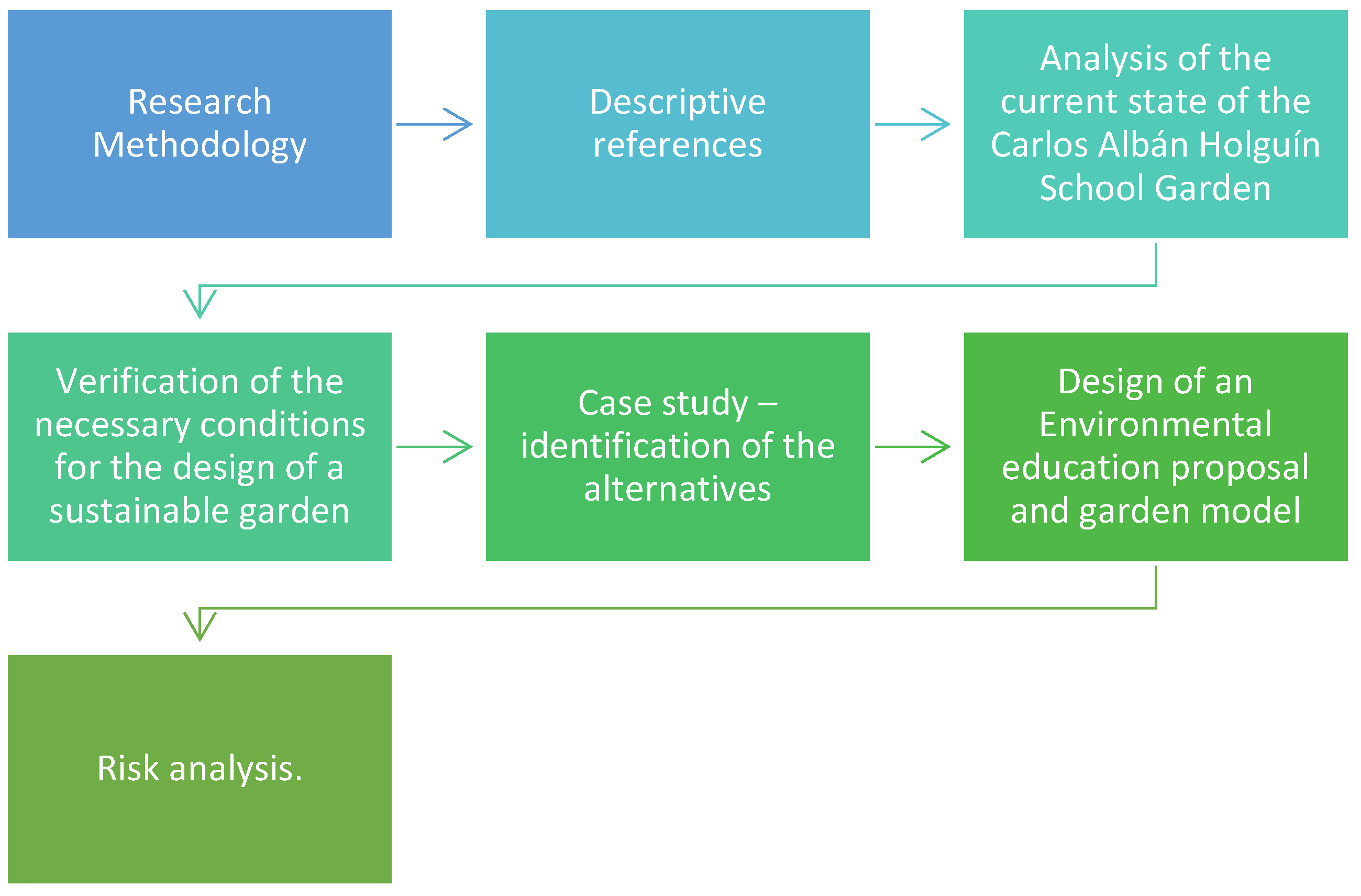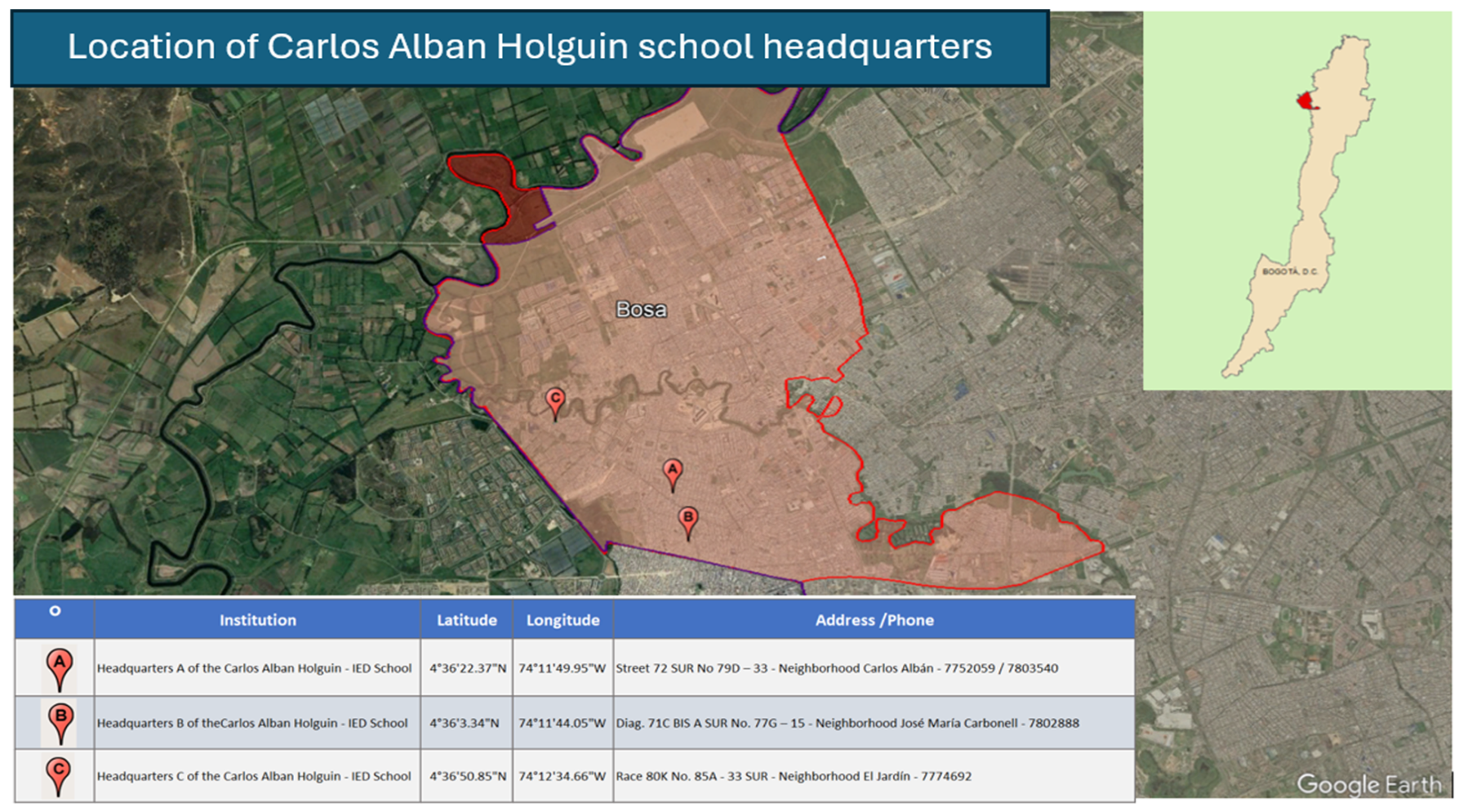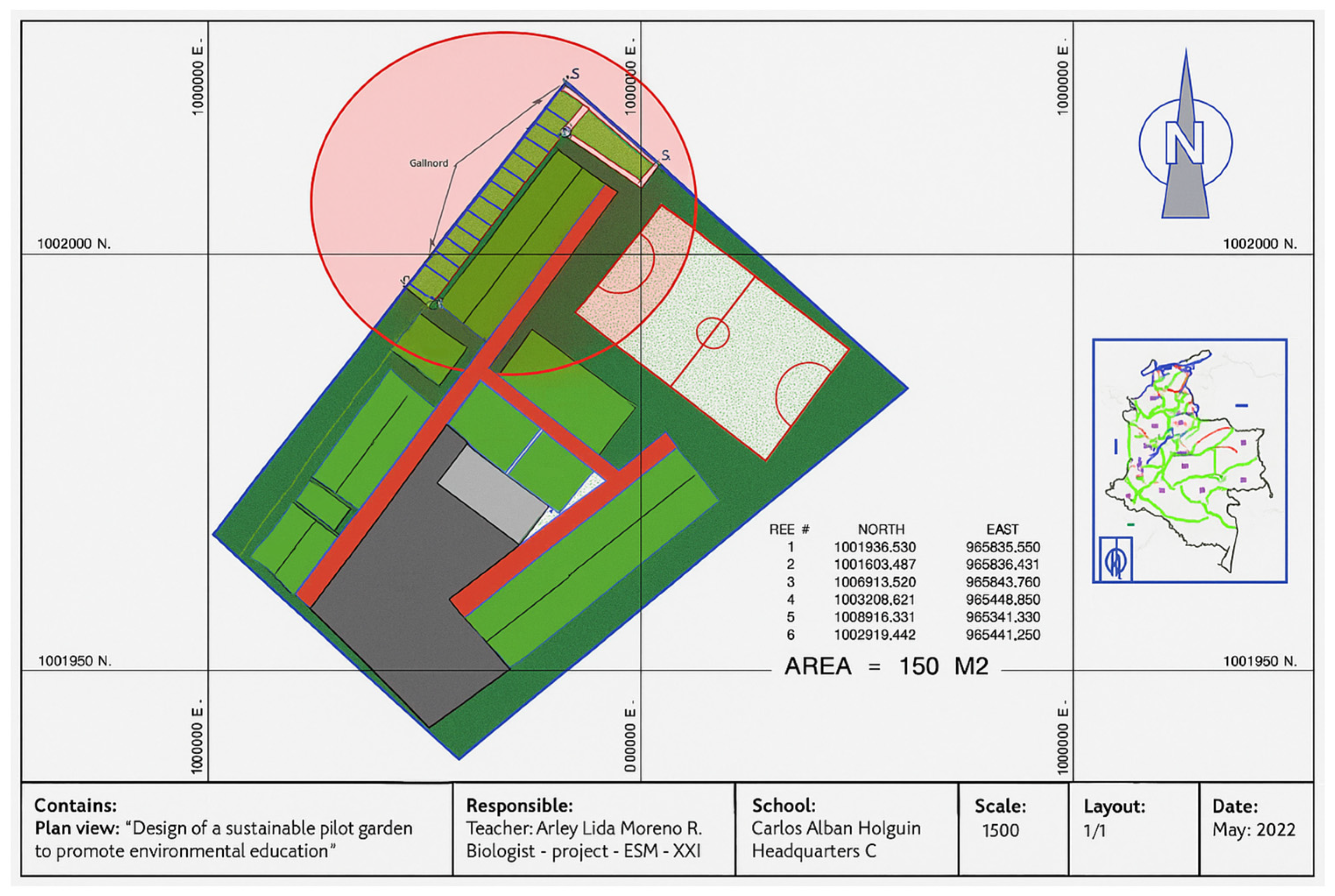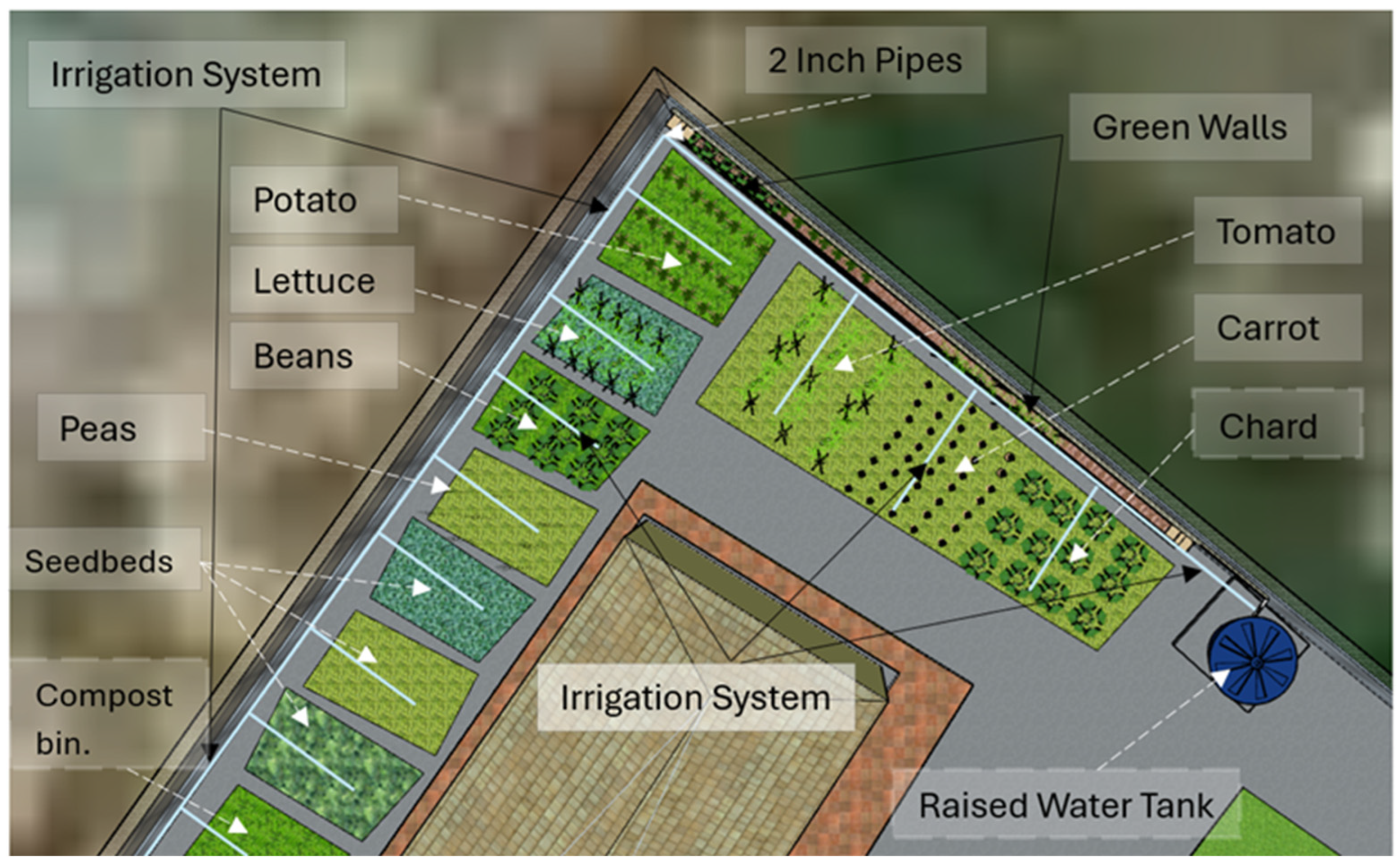Designing a Sustainable Pilot Garden to Promote Environmental Education at Carlos Albán Holguín School in Bogotá, Colombia
Abstract
1. Introduction
2. Materials and Methods
3. Results
4. Discussion
5. Conclusions
Author Contributions
Funding
Institutional Review Board Statement
Informed Consent Statement
Data Availability Statement
Conflicts of Interest
References
- Food and Agriculture Organization of the United Nations; Rikolto; RUAF. Urban and Peri-Urban Agriculture Sourcebook: From Production to Food Systems; FAO: Rome, Italy, 2022. [Google Scholar]
- James, S.W.; Friel, S. An integrated approach to identifying and characterising resilient urban food systems to promote population health in a changing climate. Public Health Nutr. 2015, 18, 2498–2508. [Google Scholar] [CrossRef] [PubMed]
- United Nations. Food and Climate Change: A Healthier Diet for a Healthier Planet. Available online: https://www.un.org/es/climatechange/science/climate-issues/food (accessed on 18 April 2024).
- Altieri, M.A.; Koohafkan, P.; Third World Network. Enduring Farms: Climate Change, Smallholders and Traditional Farming Communities; Third World Network: Penang, Malaysia, 2008. [Google Scholar]
- Guerrero-Martin, C.A.; Ortega-Ramírez, A.T.; Silva-Marrufo, Ó.; Casallas-Martín, B.D.; Cortés-Salazar, N.; Salinas-Silva, R.; Camacho-Galindo, S.; Da Silva Fernandes, F.A.; Guerrero-Martin, L.E.; Paulo de Freitas, P.; et al. Biofortification of Kidney Bean (Phaseolus vulgaris L.) Crops Applying Zinc Sulfate and Ferric Sulfate: Pilot Crop in Colombia. Molecules 2023, 28, 2004. [Google Scholar] [CrossRef]
- Fillol Mazo, A. Impact of the pandemic on global food security. Ius Human. Law J. 2023, 12, 19–49. [Google Scholar] [CrossRef]
- International Labour Organization. COVID-19 and Its Impact on Agriculture and Food Security; ILO: Geneva, Switzerland, 2020. [Google Scholar]
- Rodríguez, A.S.; Diartt, C. Food insecurity of the Venezuelan migrant population during the COVID-19 lockdown. In COVID-19: Consequences and Challenges in the Colombian Economy. A Perspective from Universities; Cortés Cortés, D., Posso-Suárez, C.M., Villamizar-Villegas, M., Eds.; Banco de la República de Colombia, Universidad del Rosario and Colombia Científica: Bogotá, Colombia, 2022; pp. 225–242. [Google Scholar]
- Restrepo Yepes, O.C.; Rodríguez Rodríguez, L.F.; Serrano García, J.M.; Martínez Durán, G. Food Security and the Right to Food in Post-Conflict Scenarios: Analysis of the “Integral Agrarian Development Policy” Agreement Between the Colombian Government and FARC-EP at the Havana Negotiation Table; Sello Editorial Universidad de Medellín: Medellín, Colombia, 2017. [Google Scholar]
- Departamento Administrativo Nacional de Estadística (DANE). Quarterly National Gross Domestic Product (GDP)—Q4 2023; DANE: Bogotá, Colombia, 2024.
- Departamento Administrativo Nacional de Estadística (DANE). Labor Force Participation, Employment, and Unemployment Rate; DANE: Bogotá, Colombia, 2024.
- Departamento Administrativo Nacional de Estadística (DANE). Consumer Price Index (CPI)—Technical Information; DANE: Bogotá, Colombia, 2024.
- Instituto Nacional de Salud. Event Report: Acute Malnutrition in Children Under 5—First Semester 2023; Instituto Nacional de Salud: Bogotá, Colombia, 2023.
- Instituto Nacional de Salud. Acute Malnutrition in Children Under 5—Epidemiological Period 03—2024; Instituto Nacional de Salud: Bogotá, Colombia, 2024.
- Aguirre Moreira, M.K.; Ortega Ponce, M.A.; Navarrete Macías, D.M.; Egüez García, K.G.; Bravo Vera, D.T.; Salazar Bowen, M.A. Food security status in hospitalized pediatric patients and its association with malnutrition. Cienc. Lat. Rev. Cienc. Multidiscip. 2023, 7, 396–411. [Google Scholar] [CrossRef]
- Departamento Administrativo Nacional de Estadística (DANE). Monetary Poverty; DANE: Bogotá, Colombia, 2023.
- Kong, Y. The role of experiential learning on students’ motivation and classroom engagement. Front. Psychol. 2021, 12, 771272. [Google Scholar] [CrossRef] [PubMed]
- Ortega-Ramírez, A.T. Conflicts and challenges for Latin America in the sustainable management of natural resources. Gest. Ambient. 2021, 24, 11–21. [Google Scholar] [CrossRef]
- Ozer, E.J. The effects of school gardens on students and schools: Conceptualization and considerations for maximizing healthy development. Health Educ. Behav. 2007, 34, 846–863. [Google Scholar] [CrossRef] [PubMed]
- Draper, C.; Freedman, D. Review and analysis of the benefits, purposes, and motivations associated with community gardening in the United States. J. Community Pract. 2010, 18, 458–492. [Google Scholar] [CrossRef]
- Kolb, D.A. Experiential Learning: Experience as the Source of Learning and Development; Prentice Hall: Englewood Cliffs, NJ, USA, 1984. [Google Scholar]
- Blair, D. The child in the garden: An evaluative review of the benefits of school gardening. J. Environ. Educ. 2009, 40, 15–38. [Google Scholar] [CrossRef]
- Tilbury, D. Environmental education for sustainability: Defining the new focus of environmental education in the 1990s. Environ. Educ. Res. 1995, 1, 195–212. [Google Scholar] [CrossRef]
- Moreno Flogia, O.; Navarrete, A.; Rodríguez Cortés, F. Teaching sustainable development and organic agriculture through a school garden. Folios Humanid. Pedagog. 2014, 1, 23–42. [Google Scholar]
- Edwards, F.; Mercer, D. Meals in metropolis: Mapping the urban foodscape in Melbourne, Australia. Local Environ. 2010, 15, 153–168. [Google Scholar] [CrossRef]
- Garnett, T. Three perspectives on sustainable food security: Efficiency, demand restraint, food system transformation. What role for life cycle assessment? J. Clean. Prod. 2014, 73, 10–18. [Google Scholar] [CrossRef]
- Hortúa Martínez, Y.H.; Velásquez Barrera, N. Strengthening Food Security and Sovereignty Through School and Home Gardens in San Antonio Village, Ubalá Municipality. Bachelor’s Thesis, Corporación Universitaria Minuto de Dios, Bogotá, Colombia, 2019. [Google Scholar]
- Carlos Albán Holguín School. Carlos Albán Holguín School—Institutional Information. Available online: https://www.cah.edu.co/ (accessed on 5 August 2024).
- Ortega Ramírez, A.T.; Reyes Tovar, M.; Silva-Marrufo, O. Rice husk reuse as a sustainable energy alternative in Tolima, Colombia. Sci. Rep. 2024, 14, 10391. [Google Scholar] [CrossRef] [PubMed]
- Vieira, L.C.; Serrao-Neumann, S.; Howes, M.; Mackey, B. Unpacking components of sustainable and resilient urban food systems. J. Clean. Prod. 2018, 200, 318–330. [Google Scholar] [CrossRef]
- Committee on World Food Security. 51st Session: Making a Difference in Food Security and Nutrition; Committee on World Food Security: Rome, Italy, 2023. [Google Scholar]
- Carrasco Beltrán, D.; Cabrera Dueñas, R.E.; Sánchez Nieto, J.D. Business Plan for the Development of Urban Gardens in Residential Complexes in Suba and Chapinero, Bogotá. Bachelor’s Thesis, Universidad EAN, Bogotá, Colombia, 2023. [Google Scholar]
- Ortega-Ramírez, A.T.; Triana-Moreno, D. Water is life: An ecofeminist perspective. In Ecotechnologies, Socio-Environmental Crisis and Post-Capitalism; Fundación Universidad de América: Bogotá, Colombia, 2021; pp. 163–192. [Google Scholar] [CrossRef]
- Pino Cabeza, M. Keys to governance in community urban gardens: Lessons from the RU:RBAN project in A Coruña. Rev. Gest. Soc. Ambient. 2022, 16, e03047. [Google Scholar] [CrossRef]





| Item | Category | Variables |
|---|---|---|
| 1 | Sustainable urban food systems | Health, society, economy, environment, governance |
| 2 | Elemental conditions for plants | Light, water, air, soil, earth, fertilizer |
| 3 | Sustainability conditions | Organic material, seeds Crop rotation, staggered sowing, crop association, crop cycle, control and monitoring, production |
| Work Completed | Variables | Score | ||||||||||
|---|---|---|---|---|---|---|---|---|---|---|---|---|
| Necessary Conditions (5) | Total | Shape (3) | Total | Area (2) | Total | Plan (5) | Total | |||||
| Water | Light | Air | Surface | |||||||||
| (1–3) | (1–3) | (1–3) | (1–3) | (1–3) | (1–3) | (1–3) | (30–90) | |||||
| Strengthening food security and sovereignty through school and home gardens in the San Antonio village, municipality of Ubalá | 2 | 2 | 2 | 2 | 40 | 2 | 6 | 2 | 4 | 2 | 10 | 60 |
| Teaching sustainable development and organic agriculture through a school garden in Sibaté | 1 | 2 | 3 | 1 | 35 | 2 | 6 | 3 | 6 | 1 | 5 | 52 |
| Species | Variables | |||||||||||
|---|---|---|---|---|---|---|---|---|---|---|---|---|
| Necessary Conditions (5) | Score | Shape (3) | Score | Area (2) | Score | Plant (5) | Score | Score | ||||
| Water | Light | Air | Surface | |||||||||
| (1–3) | (1–3) | (1–3) | (1–3) | (1–3) | (1–3) | (1–3) | (30–90) | |||||
| Tomato | 2 | 3 | 2 | 1 | 40 | 1 | 3 | 1 | 2 | 1 | 5 | 50 |
| Potato | 2 | 2 | 2 | 2 | 40 | 2 | 6 | 2 | 4 | 2 | 10 | 60 |
| Carrot | 3 | 3 | 3 | 3 | 60 | 3 | 9 | 3 | 6 | 3 | 15 | 90 |
| Onion | 1 | 1 | 1 | 1 | 20 | 1 | 3 | 1 | 2 | 1 | 5 | 30 |
| Scallion | 1 | 1 | 1 | 1 | 20 | 1 | 3 | 1 | 2 | 1 | 5 | 30 |
| Lettuce | 2 | 3 | 2 | 1 | 40 | 2 | 6 | 2 | 4 | 2 | 10 | 60 |
| Chard | 2 | 2 | 2 | 3 | 45 | 2 | 6 | 2 | 4 | 3 | 15 | 70 |
| Bean | 2 | 2 | 2 | 3 | 45 | 2 | 6 | 2 | 4 | 2 | 10 | 65 |
| Cilantro | 1 | 1 | 1 | 1 | 20 | 1 | 3 | 1 | 2 | 1 | 5 | 30 |
| Peas | 3 | 3 | 2 | 1 | 45 | 2 | 6 | 2 | 4 | 2 | 10 | 65 |
| Broad Beans | 1 | 1 | 1 | 1 | 20 | 1 | 3 | 1 | 2 | 1 | 5 | 30 |
| Item | Vegetable Garden | Pests | Improvement Actions | |||||
|---|---|---|---|---|---|---|---|---|
| Impact | Possibility | |||||||
| High | Half | Low | Frequent | Possible | Remote | |||
| 1 | Lack of appointment of responsible teacher | X | X | |||||
| 2 | Lack of support from senior management | X | X | |||||
| 3 | Lack of student interest | X | ||||||
| 4 | Accidents with tools | X | X | Educate on and monitor proper use of tools | ||||
| 5 | Climatic factors affecting crops | X | X | Install tents to protect crops from frost | ||||
| 6 | Lack of seeds and supplies | X | X | Procure products through the education institution | ||||
| 7 | Garden maintenance during holiday season | X | X | Designate garden maintenance to administrative staff and educators, highlighting their integral role in maintaining the garden’s health and beauty | ||||
| 8 | Theft of harvested products | X | Ensure adequate disposition of products | |||||
| 9 | Loss of tools | X | X | Provide adequate tools | ||||
| 10 | Incursion of unauthorized students who trample or damage crops | X | X | Build an enclosure for the garden that prevents unauthorized passage | ||||
| Garden Species | Cultivation Cycle | Distance Between Plants |
|---|---|---|
| Tomato | The tomato cultivation cycle from sowing to harvest ranges between 120 and 180 days, depending on variety used and climatic conditions. Hybrid species can exceed 8 months of cultivation. | The distance depends on plant size; to grow large tomatoes, cm between plants and 1.10 m between simple furrows is required. To grow small- or medium-sized fruits, planting is completed at short distances of 30 cm between plants and 1 m between furrows. |
| Potato | The potato cultivation cycle goes from sowing to harvest in a period of 6 months (180 days). For harvesting, the physiological maturity of the plant must be considered, which is shown by the wilting of the foliage. | The distance is determined by variety. It is recommended to maintain 30–40 cm between plants and 70–80 cm between furrows. |
| Carrot | The carrot cultivation cycle is 75–125 days. | Carrots are sowed in furrows spaced 45 cm apart and 7–8 cm between plants. |
| Lettuce | Lettuce plants should be cut at ground level. Harvesting, depending on the variety, takes place approximately 60–70 days after sowing. Head lettuce varieties are harvested in 80–90 days. | There should be 25 cm left between plants and 30 cm between furrows. |
| Chard | Leaf length is a visual indicator of harvest time (25 cm), averaging 60–70 days for the first cut and then every 12–15 days. It is recommended to cut the leaves with knives at the hearth or point of growth. In this way, an average production of 13 kilos per square meter can be obtained. | The distance should be 35 cm between plants and 40–50 cm between furrows. |
| Bean | The time to harvest depends on the objective. If it is going to be harvested as green beans in peel, it should be performed when the grain is already formed. The duration of the crop from sowing to harvesting as dry grain is 120–240 days. | The distance between furrows is 40–60 cm and 10 cm between plants. |
| Peas | The pea cultivation cycle starts from when the plants are born until flowering and fruiting begins, from 90 to 120 days depending on climatic conditions and variety. | The distance is 40 cm between furrows and 20 cm between plants. |
Disclaimer/Publisher’s Note: The statements, opinions and data contained in all publications are solely those of the individual author(s) and contributor(s) and not of MDPI and/or the editor(s). MDPI and/or the editor(s) disclaim responsibility for any injury to people or property resulting from any ideas, methods, instructions or products referred to in the content. |
© 2025 by the authors. Licensee MDPI, Basel, Switzerland. This article is an open access article distributed under the terms and conditions of the Creative Commons Attribution (CC BY) license (https://creativecommons.org/licenses/by/4.0/).
Share and Cite
Ortega-Ramírez, A.T.; Moreno, A.L.; Luna Correa, J.E.; Reyes Tovar, M.; Silva-Marrufo, O.; Caballero Olvera, M.A. Designing a Sustainable Pilot Garden to Promote Environmental Education at Carlos Albán Holguín School in Bogotá, Colombia. Sustainability 2025, 17, 7570. https://doi.org/10.3390/su17177570
Ortega-Ramírez AT, Moreno AL, Luna Correa JE, Reyes Tovar M, Silva-Marrufo O, Caballero Olvera MA. Designing a Sustainable Pilot Garden to Promote Environmental Education at Carlos Albán Holguín School in Bogotá, Colombia. Sustainability. 2025; 17(17):7570. https://doi.org/10.3390/su17177570
Chicago/Turabian StyleOrtega-Ramírez, Angie Tatiana, Arley Lida Moreno, José Enrique Luna Correa, Miriam Reyes Tovar, Oscar Silva-Marrufo, and Miriam América Caballero Olvera. 2025. "Designing a Sustainable Pilot Garden to Promote Environmental Education at Carlos Albán Holguín School in Bogotá, Colombia" Sustainability 17, no. 17: 7570. https://doi.org/10.3390/su17177570
APA StyleOrtega-Ramírez, A. T., Moreno, A. L., Luna Correa, J. E., Reyes Tovar, M., Silva-Marrufo, O., & Caballero Olvera, M. A. (2025). Designing a Sustainable Pilot Garden to Promote Environmental Education at Carlos Albán Holguín School in Bogotá, Colombia. Sustainability, 17(17), 7570. https://doi.org/10.3390/su17177570








